
Suffolk is a ceremonial county in the East of England and East Anglia. It is bordered by Norfolk to the north, the North Sea to the east, Essex to the south, and Cambridgeshire to the west. Ipswich is the largest settlement and the county town.

Edmund the Martyr was king of East Anglia from about 855 until his death.
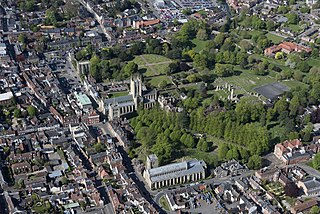
Bury St Edmunds, commonly referred to locally as Bury, is a cathedral as well as market town and civil parish in the West Suffolk district, in the county of Suffolk, England. The town is best known for Bury St Edmunds Abbey and St Edmundsbury Cathedral. Bury is the seat of the Diocese of St Edmundsbury and Ipswich of the Church of England, with the episcopal see at St Edmundsbury Cathedral. In 2011, it had a population of 45,000. The town, originally called Beodericsworth, was built on a grid pattern by Abbot Baldwin around 1080. It is known for brewing and malting and for a British Sugar processing factory, where Silver Spoon sugar is produced. The town is the cultural and retail centre for West Suffolk and tourism is a major part of the economy.
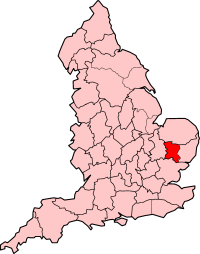
West Suffolk was an administrative county of England created in 1889 from part of the county of Suffolk. It survived until 1974 when it was rejoined with East Suffolk. Its county town was Bury St Edmunds.
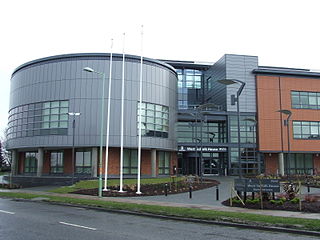
St Edmundsbury was a local government district and borough in Suffolk, England. It was named after its main town, Bury St Edmunds. The second town in the district was Haverhill. The population of the district was 111,008 at the 2011 Census.
This article describes the history of Suffolk, the English county.

The Abbey of Bury St Edmunds was once among the richest Benedictine monasteries in England, until its dissolution in 1539. It is in the town that grew up around it, Bury St Edmunds in the county of Suffolk, England. It was a centre of pilgrimage as the burial place of the Anglo-Saxon martyr-king Saint Edmund, killed by the Great Heathen Army of Danes in 869. The ruins of the abbey church and most other buildings are merely rubble cores, but two very large medieval gatehouses survive, as well as two secondary medieval churches built within the abbey complex.

Bury St Edmunds was a constituency in Suffolk from 1621 to 2024, most recently represented in the House of Commons of the UK Parliament from 2015 to 2024 by Jo Churchill, a Conservative.

Long Melford, colloquially and historically also referred to as Melford, is a large village and civil parish in the Babergh district, in the county of Suffolk, England. It is on Suffolk's border with Essex, which is marked by the River Stour, 3 miles (4.8 km) from Sudbury, approximately 16 miles (26 km) from Colchester and 14 miles (23 km) from Bury St Edmunds. It is one of Suffolk's "wool towns" and is a former market town. The parish also includes the hamlets of Bridge Street and Cuckoo Tye. In 2011 the parish had a population of 3918.

Suffolk County Council is the upper-tier local authority for the county of Suffolk, England. It is run by 75 elected county councillors representing 63 divisions. It is a member of the East of England Local Government Association.
The Suffolk Youth Orchestra (SYO) is a symphony orchestra of over 90 players aged between 13 and 21 years. It is part of Suffolk County Council's programme of youth music.
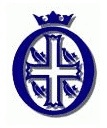
Bury St Edmunds County High School, previously Bury St Edmunds County Upper School, is a 13 to 19 co-educational comprehensive part of the Bury St Edmunds All-Through Trust, comprising County High School, Horringer Court School, Westley School and Barrow CEVC and Tollgate Primaries.
David Lale is a cellist from the United Kingdom. He is a member of the Lale String Quartet and plays regularly in a number of orchestras in the UK including the BBC Symphony Orchestra and the Philharmonia Orchestra. David is the nephew of Australian cellist David Lale.

St Mary's Church is the civic church of Bury St Edmunds in Suffolk, England and is one of the largest parish churches in England. It claims to have the second longest nave, and the largest West Window of any parish church in the country. It was part of the abbey complex and originally was one of three large churches in the town.

Dominic Seldis is a British double bass soloist and principal double bass of the Royal Concertgebouw Orchestra.

West Suffolk County Council was the county council of the non-metropolitan county of West Suffolk in east England. It came into its powers on 1 April 1889 and acted as the governing authority for the county until it was amalgamated with East Suffolk County Council to form Suffolk County Council in 1974. The county council was based at the Shire Hall Complex in Bury St Edmunds.
Aurora Orchestra is a British chamber orchestra, co-founded in 2004 by conductors Nicholas Collon and Robin Ticciati. The orchestra is based in London, where it is Resident Orchestra at Southbank Centre and Resident Ensemble at Kings Place. The orchestra was also previously Associate Orchestra at LSO St Luke's, and performs regularly at other venues including St George's, Bristol, the Colyer-Fergusson Hall in Canterbury, and The Apex in Bury St Edmunds. It has developed a particular reputation for creative programming and concert presentation, including pioneering memorised performance as a regular feature of its artistic output. Since its launch in 2005, it has worked with artists ranging from Ian Bostridge, Brett Dean, Anthony Marwood and Sarah Connolly to Edmund de Waal, Wayne McGregor and Björk.

West Suffolk Hospital is a small district general hospital in Bury St Edmunds, England. It is managed by the West Suffolk NHS Foundation Trust.
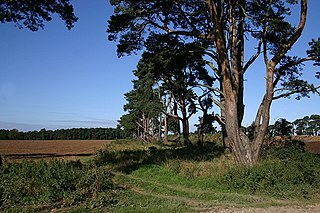
West Suffolk District is a local government district in Suffolk, England. It was established in 2019 as a merger of the previous Forest Heath District with the Borough of St Edmundsbury. The council is based in Bury St Edmunds, the district's largest town. The district also contains the towns of Brandon, Clare, Haverhill, Mildenhall and Newmarket, along with numerous villages and surrounding rural areas. In 2021 it had a population of 180,820.
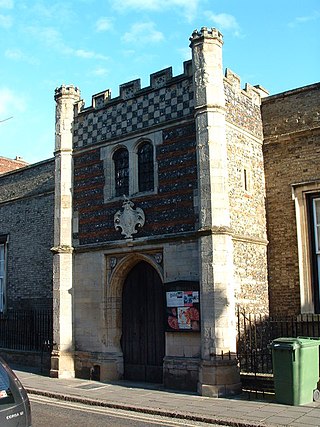
Bury St Edmunds Guildhall is a municipal building in the Guildhall Street, Bury St Edmunds, Suffolk. It is a Grade I listed building.















